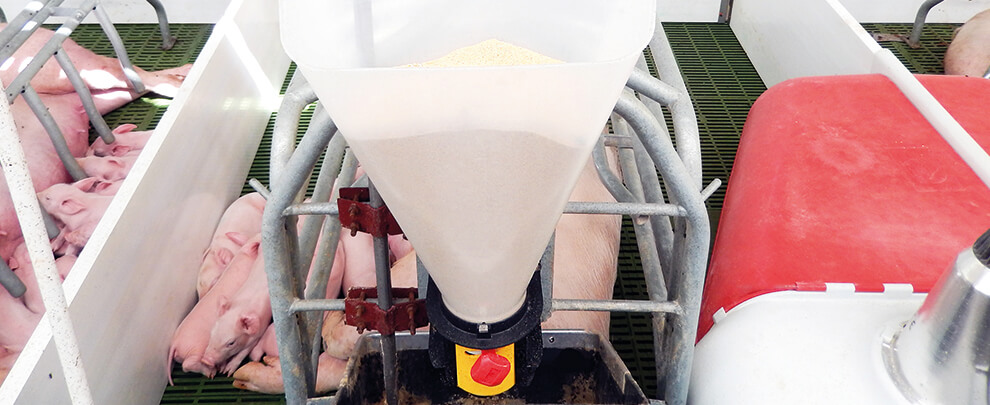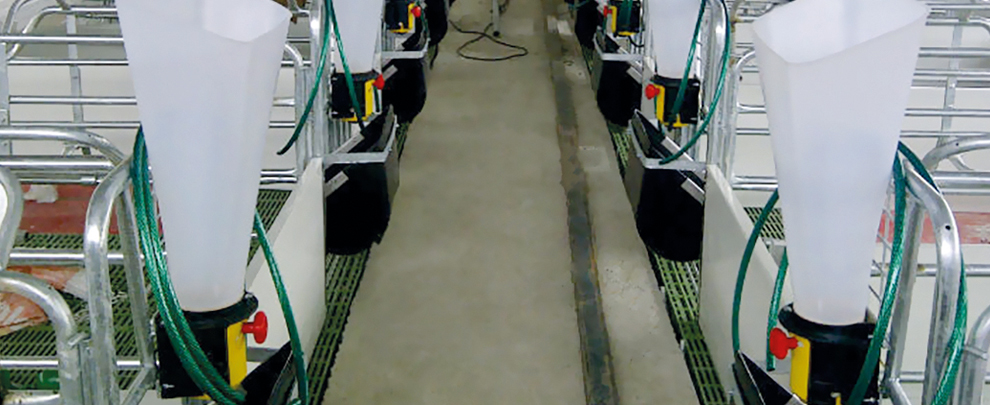Blog
Blog

How can we maximize feed intake in lactating sows?
07 of October of 19 - Studies
While sows are lactating, their energy balance is often negative, since the requirements for maintenance and especially for milk production are higher than those provided by their feed intake. Furthermore, every day we find farms with ever more prolific genetics, which demands greater milk production to feed an ever-growing litter. As a result of this negative balance, the sows tend to lose body condition during this stage. Several studies show that excessive weight loss during lactation lengthens the weaning-mating interval and reduces the ovulation rate, which not only affects the results of subsequent reproduction, but also the prolificacy of the next litter. Consequently, stimulating feed intake in lactating sows is a priority to wean piglets with good weight, minimise the loss of body condition of the sows and obtain good results in the next reproductive cycle. The feed consumption is influenced by many factors, such as the ambient temperature, genetics, parity, health status, body condition of the sow, etc., but the food supply system is as important as these factors.
The Feeding Ball is a slow drop dispenser particularly suitable for farrowing, which allows restricted or ad libitum feeding of sows, with which the maximize feed intake in weaning is achieved. The animal quickly learns how to operate the mechanism with its natural rooting movement and the easy accessibility of the ball. Furthermore, the availability of feed on demand for the animal allows the sows to eat fresh feed 24 hours the day, depending on their appetite, and wastage is minimised because, this way, no large portions of food are supplied suddenly. So, we ensure the needs of the sow are met, while avoiding wasting food, an essential factor if you consider that food is the main cost on pig farms.
MATERIAL AND METHODS
To corroborate the advantages of this feeding mechanism in lactation, a study was conducted on a commercial piglet farm. The holding in question, Albiporc SLU, with 640 productive sows of the Nucleus genetic, is located in the province of Lleida and is integrated in the Vall Companys company. The test was conducted in two lactation rooms, with 12 places each. Sows had a stainless trough with a nipple with a flow rate of about 2-2.5 l / min, plus a supplementary tap for additional water after each meal. Ventilation was forced, with an objective ambient temperature of 23 °C.

The test was conducted with a total of 258 sows, divided into 22 lots. The experimental design included two treatments: control and Feeding Ball. In the control, the existing management that already had the operation, with two daily feed supplies, while in the Feeding Ball treatment, management was the same as in the control until 6, but from day 7 post-partum, the sows were fed ad libitum until weaning. Within each lot, sows were randomly assigned to one of the two treatments, depending on the number and date of birth. Litters of piglets were balanced between treatments for weight and number of piglets, and in neither treatment did the piglets have access to feed. The experimental pre- and post- lactation management was the same for all animals.
To evaluate the effect of the treatments on growth performance, a set of parameters was registered for the sow and piglets during the experimental lactation. First, the individual feed intake and the nocturnal consumption (18h-8h) of sows with the Feeding Ball was monitored. To assess the loss of body condition, the backfat thickness and live weight of the sows were measured. With regard to piglets, the weight of litters and mortality from postpartum until weaning were recorded. Following the experimental lactation, the results of the heat of the sows, and the prolificacy of the next litter were followed.
RESULTS AND DISCUSSION
The test results show that the Feeding Ball is a very effective mechanism to maximise feed intake in lactation, even compared to a finely-tuned manual supply system. Daily consumption per sow, from birth until weaning (approximately 21 days), increased by almost half a kilo with the Feeding Ball (6.91 kg / day) compared to the control (6.42 kg/day), with statistically significant differences. The second week of lactation was when higher consumption differences between treatments (more than 1.5 kg / day) were obtained, as this was when the sows were freed to feed ad libitum with the Feeding Ball. There are several reasons that can explain the high feed consumption achieved with the Feeding Ball. First, the device allows not only rationed feeding but also ad libitum. Thus, we ensure that we cover each sow’s individual appetite, while we avoid wasting food by overdoing the ration. Keep in mind that lactating consumption varies not only depending on the number in the litter, but also according to the state of the sows. Very fat sows tend to cause problems of consumption in lactation, resulting in lighter piglets, despite the notable body reserves of the sow. Another very important advantage of the Feeding Ball is that the animal always has fresh food, since it is the sow that decides when to eat. This feature allows the sows to eat more at night in warmer seasons when consumption in lactation is more critical. In addition, the Feeding Ball not only reduces the manpower needs to regulate the dosage of each sow, but also means less reliance on strict schedules to supply feed 2-3 times a day, especially with hyperprolific genetics where consumption requirements are greater.
What does this increase in feed intake of sows fed with the Feeding Ball lead to? In this case, less loss of body condition in the sows was observed, both for weight and backfat thickness. Although the sows in the control treatment obtained very good results, with an average weight loss of only 1.3 kg and a decrease of 2.1 mm in backfat during lactation, statistically significant differences were observed in both parameters with the Feeding Ball treatment. In the test, the sows with the Feeding Ball gained weight during lactation (2.58 kg) and only lost 1.2 mm of backfat (Table 1). Still, no differences in the subsequent oestrus or prolificacy in the next delivery were observed. The low weight loss of sows in the control treatment (-0.5%) may explain why no differences between treatments were observed in post weaning parameters as the literature refers to higher weight losses 10-15% with a significant impact on these parameters.
Regarding the piglets, no significant differences in weaning weight between treatments were observed. However, very good results were obtained in both groups, with a weaning weight of almost 6.4 kg, with and average lactation of around 21 days. Several literature sources mention the priority of lactating sows for milk production to feed piglets, at the expense of loss of body weight. This property would explain the fact that increased feed intake of sows Feeding Ball resulted in a smaller loss of body weight in the sows, but no differences were observed in the growth of the piglets.
CONCLUSIONS
Each day, we find more prolific sows on the farms. This implies higher feed consumption requirements in the lactation stage, when the energy balance is usually negative. These requirements make the Feeding Ball a very effective mechanism, allowing increased feed consumption in maternity (0.5 kg/day in this study), minimising the loss of body condition (we found sows even gained weight) and letting the sow control her own consumption based on her individual needs.
Although the study results were very positive, on a farm with a less productive control and even more prolific sows, one would expect the differences between the control treatment and Feeding Ball to be greater.






